The project ACXIS brings together the expertise in X-ray cargo inspection of leading research centres in Germany, France and Switzerland, the major European supplier for cargo inspection systems, a research and development organisation focusing on training of X-ray inspection officers, and Customs administrations of the Netherlands and Switzerland. The main objectives of this project are to implement a manufacturer independent reference database for X-ray images of illegal and legal cargo, to develop procedures and algorithms in order to uniform X-ray images of different cargo scanners, to develop a training simulator for inspection officers and a toolbox enclosing several assisted / automated identification techniques for potentially illegal cargo. Historic images of real detections, images of illegal cargo mock-ups as well as images of legitimate cargo will be integrated into the reference database.
Improved inspection procedures
Effective and efficient border controls are essential in today’s world of trade and the threats that exist to our societies. Customs administrations are responsible for the enforcement of the fiscal integrity and security of the movements of goods across these borders. At the same time, Customs administrations are expected to make a contribution to the economic competitiveness of the nation they represent. The increasing amounts of goods that pass their checkpoints require innovative inspection procedures. Automatic detection at border controls plays an important role in the vision of the Customs administration of the Netherlands and the Federal Customs administration of Switzerland.
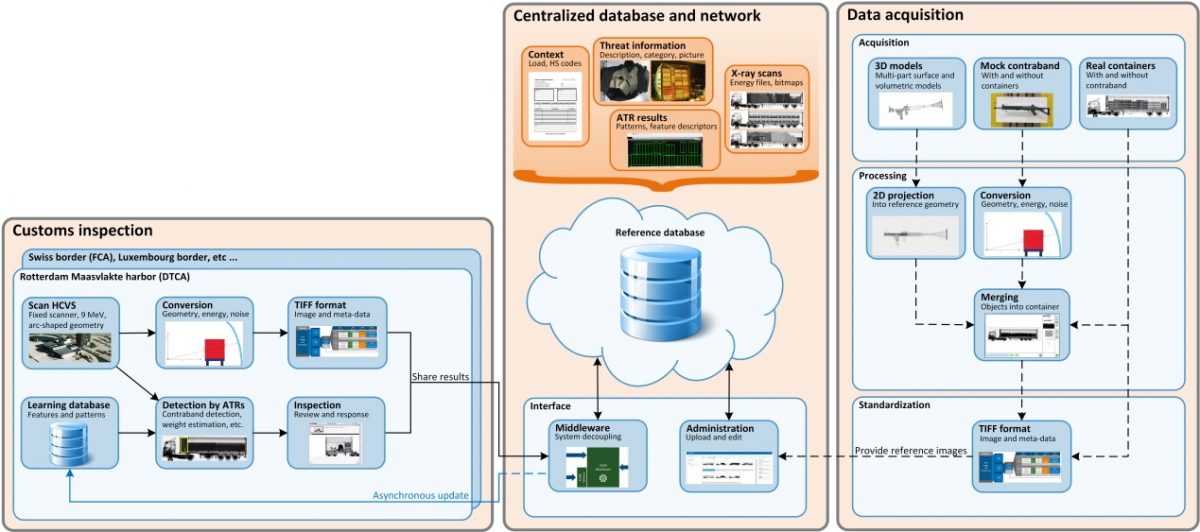
ACXIS develops automated target recognition (ATR) functions to analyse images issued from X-ray scans of cargo shipments inspected at land, air or sea border crossing points. With the new procedures proposed by the ACXIS project, the Customs officers will carry out the inspection helped by ATR functions available on-demand. They will be able to annotate the results and to share them with other agencies, through a secure system. The X-ray data will be converted into a standardized format, and stored in a database, along with the results of the ATRs and other annotations (Fig. 1). This standardization allows comparisons between scans from X-ray machines of different manufacturers and models. The database is loaded with a large array of reference material, and new scans are continuously integrated.
Reference database: mock-up scans and database integration
Based on risk analysis conducted by the Customs administrations, threat objects and their locations in the container were identified. Following their recommendations, a set of mock-ups was created with real threat items and simulants, combined with common goods (Fig. 2). These were scanned using laboratory systems, and some with a cargo scanner, chosen as reference. The main objective of these mock-up scans was to enlarge the variety of threat images. For the same purpose, simulation tools were also used in order to generate X-ray images from 3D models of various types of threat items (e.g. weapons).

Between all classes of threats, few more details are given on two items. Tobacco products are principally legal, but with a fairly high taxation on them. Therefore it can be interesting to bring untaxed cigarettes in large amounts to the black market. Due to the relatively low density, the cigarettes themselves are hardly visible behind more massive materials; however, their packaging has a certain texture that can be detected. Another class of risk items is the shielding containers of radiographic Gamma-ray sources, used generally in the non-destructive testing (NDT) field. The transport of such containers is legal, but needs an adequately equipped and identified vehicle, and specially trained drivers. The heavy shielding necessary for such sources is made from lead or depleted uranium and, therefore, creates opaque regions on the X-ray image because of the high attenuation of the beam. These areas are visually analysed, but automatic algorithms could also be employed.
All the images from the database, and especially the ones containing threats, will provide a large basis for training of screening officers and also for machine learning methods in automated detection algorithms.
A unified X-ray image standard
When analysing X-ray images, the human brain easily adapts to other different systems, regardless the possible geometric deformations, various textures and different levels of contrast or noise, which is not the case for automatic algorithms. Since a large variety of X-ray scanners are installed at border checkpoints, the analysed images need to be similar in terms of the aforementioned parameters. Standardising these images is a preparation step and is mandatory for good detection performances.
Image processing and automated detection algorithms
Physical processes involved in digital X-ray imaging were studied and accurate models were developed in order to take into account the differences between the various x-ray scanners. Geometric adaptation is perhaps the most challenging since projecting a complex load from distant view angles generates different distortions in the resulting image. However, an approach which selects the most similar ray paths and makes use of the standardised container dimensions gives satisfactory conversion results as shown in Fig. 3. The example shows a conversion of a Euromax image (top) to a SH-HCVS image appearance (bottom) that looks very similar to a genuinely obtained SH-HCVS image (middle).
Contrast corrections take into account the source spectra and typical phantoms are used to estimate several attenuation points, which are then fitted in order to use the obtained curves for adjustments of grey level values. Several noise reduction algorithms were evaluated in order to select the best one to reduce the noise to the level of the reference scanner, without affecting the image quality (e.g. the texture or the sharpness).
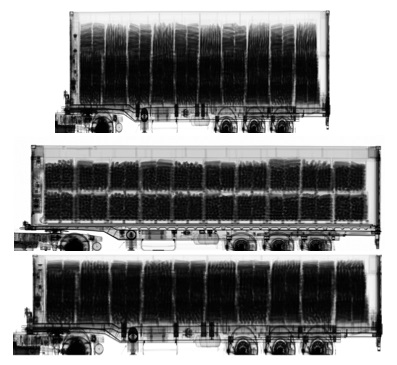
The ultimate goal is to provide assisted/automated detection techniques of threats through dedicated algorithms. Several illicit goods detection scenarios were selected and prioritised. Several approaches of complementary assisted/automated detection techniques have been investigated according to the various envisioned scenarios, such as image comparison, load characterization, and direct target detection. Three examples are given in the following.
Automated Detection of Cigarettes
Methods for cigarettes detection based on texture analysis are being developed and show promising results. For instance the load in Fig. 4 is automatically identified as cigarettes packs and a warning is displayed to the screening officer.
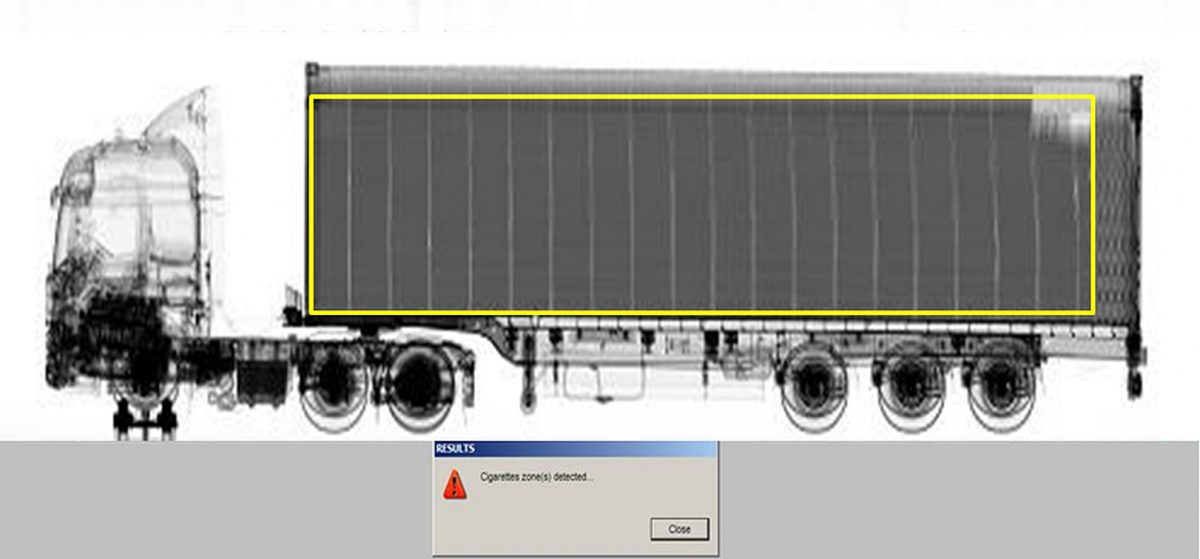
Weight Estimation
A tool to help the operators to analyse the load of a cargo container is the weight estimation. In the process of analysing the load, it is often helpful to match areas on the X-ray image of the load with the goods marked on the waybill. This software tool will give an indication of the actual weight to be compared with the declarations, as shown in Fig. 5.
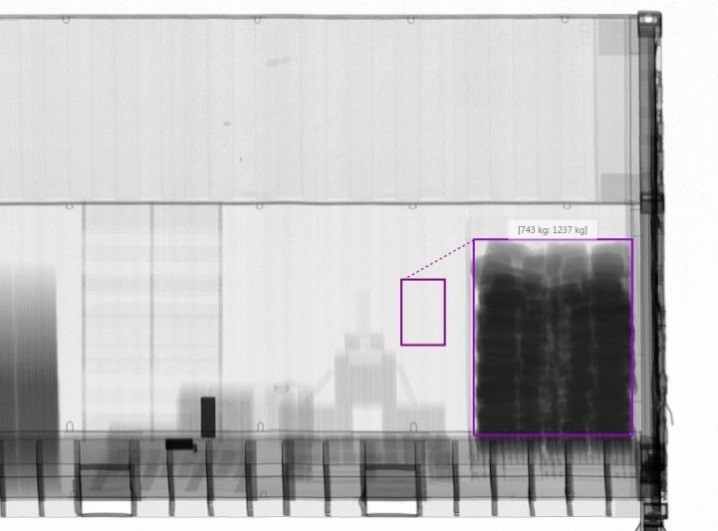
Image Irregularity Detection
Instead of searching to detect specific threats which might me missed because of their large variety, a very helpful approach is to detect irregularities. A tool has been developed which will point out areas showing irregularities which will then be analysed in details by the screening officer. Through advanced image processing algorithms employing registration techniques, a difference image with respect to a reference will give indications of irregularities, as indicated in Fig. 6.

Training the Customs officers
A software application is developed to provide focused training on X-ray image interpretation and decision making, and to periodically evaluate the performance of Customs officers (Fig. 7). The user interface is carefully designed to resemble various X-ray scanning systems, and includes the most important support functions, such as zooming, image filters and enhancements. The behaviour of the ATR functions are simulated with the placement of coloured frames in the image that indicate the possible existence of suspicious goods. The user receives feedback upon making a decision whether the cargo should be subject to further inspection, informing him whether his answer was correct and which suspicious goods are part of the cargo.
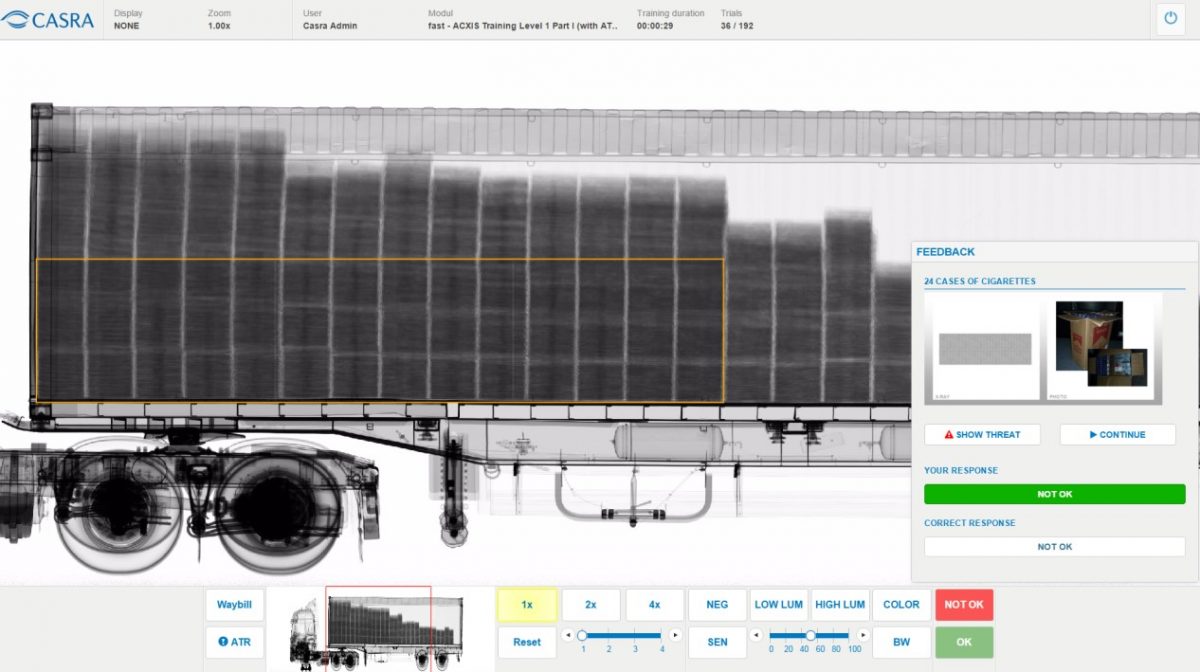
The impact of the ATRs on the performance of Customs officers is evaluated through a validation study. A group of operators is selected for training during which they are presented with simulations of X-ray scans of shipments that are annotated with the detection results of the ATRs. The performances of these participants are compared against a control group.

Training and test modules have been developed for the simulation software (Fig. 8). The training modules automatically adjust the training difficulty to the level of expertise of the user. Supervised learning is guaranteed by providing the user with feedback after each image. The test modules are standardised packages that enable reliable and valid means to carry out initial and recurrent evaluation of Customs officers. These methodologies are rooted in behavioural psychology and have been applied to airport security personnel for many years with great success.















